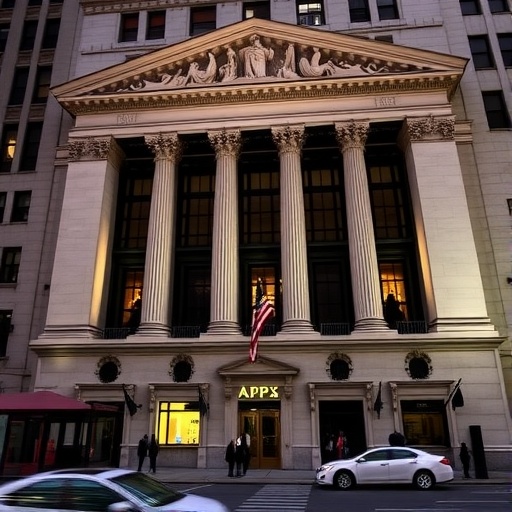As the U.S. government shutdown stretches into its third week, Wall Street traders are laser-focused on a critical alternative: the ADP private payrolls report due Wednesday. With official jobs data from the Bureau of Labor Statistics (BLS) postponed indefinitely, this private-sector snapshot could provide the first real glimpse into the labor market’s health amid escalating economic uncertainty. Economists anticipate a modest rebound in hiring, projecting around 150,000 new jobs added in September, but fragility lingers as federal workers face unpaid furloughs and broader ripple effects threaten consumer spending.
ADP Report Emerges as Lifeline for Investors
The ADP National Employment Report, often dubbed the ‘private payrolls’ precursor to official figures, has taken center stage on Wall Street. Released by Automatic Data Processing Inc. (ADP) in collaboration with the Stanford Digital Economy Lab, this monthly gauge tracks nonfarm private employment based on actual payroll data from over 25 million U.S. employees. In August, ADP reported a disappointing 177,000 jobs added, falling short of expectations and signaling a cooling labor market pressured by high interest rates and softening demand.
For September, forecasts from economists at firms like Goldman Sachs and JPMorgan Chase point to a slight uptick to 150,000-160,000 jobs, driven by gains in leisure, hospitality, and professional services sectors. ‘This report isn’t just data—it’s a barometer for how businesses are navigating the shutdown’s chaos,’ said Mark Zandi, chief economist at Moody’s Analytics, in an interview with Reuters. Zandi emphasized that while the numbers may show resilience, they could mask underlying weaknesses, such as delayed hiring in government-dependent industries like defense contracting.
Wall Street‘s fixation on ADP stems from its historical correlation with BLS data—typically within 20,000-30,000 jobs of the official tally. However, discrepancies have widened in recent months due to sampling differences and the inclusion of only private-sector jobs in ADP’s metric. Traders are betting that a stronger-than-expected reading could bolster stock futures, particularly for cyclical sectors like industrials and consumer discretionary, which have dipped 2-3% since the shutdown began on October 1.
To illustrate the stakes, consider the S&P 500’s reaction to past ADP releases: In July, a surprise 324,000-job surge propelled the index up 0.8% intraday. Conversely, a weak print in June triggered a 0.5% sell-off. With the Dow Jones Industrial Average hovering near 42,000 amid volatility, any deviation from consensus could amplify swings in major indices.
Government Shutdown Paralyzes Key Economic Indicators
The ongoing government shutdown, triggered by partisan disputes over spending bills, has halted operations at non-essential federal agencies, including the BLS. This marks the third such impasse in a decade, affecting over 800,000 civilian employees who are furloughed without pay. The delay in the September nonfarm payrolls report—originally scheduled for October 6—has created a data vacuum, forcing investors to rely on proxies like ADP and alternative indicators such as jobless claims and consumer confidence surveys.
Historically, shutdowns have short-term economic drags: The 2018-2019 event, lasting 35 days, shaved an estimated 0.1-0.2% off GDP growth, according to the Congressional Budget Office (CBO). This time, with inflation cooling but recession fears mounting, the labor market is particularly vulnerable. Federal Reserve Chair Jerome Powell noted in a September speech that ‘disruptions like these add unnecessary uncertainty to an already delicate recovery.’
Beyond payrolls, the shutdown is stalling other vital releases, including retail sales, industrial production, and housing starts data. For Wall Street, this opacity heightens risks in options trading and algorithmic strategies tuned to economic calendars. ‘We’re flying blind on official numbers, which means volatility spikes are inevitable,’ warned Beth Ann Bovino, chief U.S. economist at U.S. Bank Wealth Management. She predicts that once resolved, backlogged data could reveal a more subdued labor market than ADP suggests, with unemployment potentially ticking up from 4.2% to 4.3%.
The human cost is stark: Furloughed workers, from park rangers to IRS staff, are dipping into savings, curbing spending that fuels 70% of the economy. Small businesses, which account for 47% of private payrolls per ADP’s own data, report hesitation in hiring due to fears of prolonged uncertainty. A survey by the National Federation of Independent Business (NFIB) found 25% of owners planning to delay expansions until the shutdown ends.
Labor Market Shows Signs of Strain Beneath Surface Rebound
Despite expectations of a payrolls rebound, the broader labor market exhibits fragility. Wage growth, a key inflation driver, slowed to 3.9% year-over-year in August per BLS, yet remains above the Fed’s 2% target. ADP’s wage index for September is forecasted to hold steady at 4.1%, but sector-specific trends reveal divides: Healthcare added 28,000 jobs last month, while manufacturing shed 12,000 amid supply chain woes exacerbated by the shutdown.
Regional disparities add complexity. In tech hubs like California and Texas, private payrolls in information services grew 1.2% quarter-over-quarter, buoyed by AI investments. Conversely, the Midwest’s auto sector, hit by strikes and federal funding halts, saw a 0.8% contraction. ADP’s breakdown highlights these nuances: Leisure and hospitality, rebounding from pandemic lows, are projected to contribute 40,000 jobs, but construction—reliant on government contracts—may stagnate at just 10,000.
Experts like Julia Coronado, founder of MacroPolicy Perspectives, caution that the labor market’s ‘soft landing’ narrative is fraying. ‘ADP might paint a rosy picture, but quit rates are at multi-year lows, signaling worker caution rather than confidence,’ she told CNBC. Indeed, the JOLTS report from August showed job openings dipping to 8.1 million, the lowest since February 2021, while hires fell to 5.6 million.
Demographic shifts are also at play. The participation rate for prime-age workers (25-54) stands at 83.4%, near pre-pandemic levels, but older workers (55+) are exiting faster, per ADP data. This could pressure future payrolls if immigration policies tighten amid shutdown debates. Overall, while a modest rebound offers hope, underlying metrics suggest the labor market is treading water, vulnerable to policy missteps.
Wall Street Reacts with Cautious Optimism and Strategic Bets
Major banks are adjusting portfolios in anticipation of the ADP release. Goldman Sachs strategists recommend overweighting defensive stocks like utilities and healthcare, which comprise 20% of the S&P 500, to hedge against downside risks from the government shutdown. ‘The labor market’s resilience will be tested, but we’re positioning for a Fed pause on rate hikes if data holds up,’ said Lindsay Rosner, a senior macro strategist at Goldman.
Options markets reflect this tension: Implied volatility for the VIX has surged 15% since the shutdown’s onset, pricing in potential 1-2% daily swings in the Nasdaq. Hedge funds are snapping up calls on ADP-sensitive ETFs like the iShares U.S. Employment ETF, betting on a positive surprise. Meanwhile, short interest in cyclical names like Caterpillar and Boeing has risen 5-7%, as investors brace for defense sector hits from furloughs.
International ripple effects are notable too. European markets, via the FTSE 100 and DAX, have mirrored U.S. caution, with a 1.1% drop last week tied to fears of delayed U.S. data influencing global trade. Asian indices like the Nikkei opened lower Monday, awaiting ADP’s read on American consumer strength, which drives 15% of Japan’s exports.
From a policy angle, the report’s outcome could sway the Federal Open Market Committee’s (FOMC) November meeting. A robust payrolls figure might reinforce the Fed’s wait-and-see stance on cuts, keeping the benchmark rate at 5.25-5.50%. But weakness could fuel dovish bets, with CME FedWatch Tool showing a 65% chance of a 25-basis-point cut by December if labor softens further.
Institutional investors are also eyeing corporate earnings season, which overlaps with the data drought. JPMorgan’s Jamie Dimon highlighted in a recent op-ed that ‘shutdown-induced uncertainty is amplifying earnings volatility, especially for firms with government exposure.’ Indeed, Lockheed Martin’s stock fell 4% post-shutdown, underscoring the labor market’s interconnectedness with fiscal policy.
Outlook Hinges on Shutdown Resolution and Fed Signals
Looking ahead, Wall Street’s gaze extends beyond ADP to potential shutdown breakthroughs. Bipartisan talks in Congress aim for a resolution by mid-October, potentially unlocking $6 billion in back pay for federal workers and restoring data flows. If prolonged, the CBO estimates a 0.3% GDP hit in Q4, pressuring the labor market with possible 100,000-200,000 job losses in affected sectors.
The ADP report could catalyze negotiations: Strong data might embolden fiscal hawks resisting spending hikes, while weakness underscores the need for stimulus. For the labor market, sustained hiring above 100,000 monthly is crucial to absorb new entrants and prevent unemployment from breaching 4.5%. Economists project that without resolution, October payrolls—once released—could show a flat or negative print, the first since the 2020 recession.
Longer-term, the episode highlights structural vulnerabilities: Over-reliance on government data amid political gridlock. Private alternatives like ADP are filling gaps, but investors crave consistency. As Powell prepares for his next Jackson Hole address, markets will parse every signal for clues on rate paths, with the labor market at the epicenter.
In this high-stakes environment, Wall Street remains poised: A modest rebound via ADP could stabilize sentiment, but fragility persists. Traders are advised to monitor real-time indicators like initial claims (due Thursday) and ISM services PMI for corroboration. Ultimately, resolving the government shutdown isn’t just about budgets—it’s about safeguarding the labor market’s momentum in an era of economic tightrope walking.









